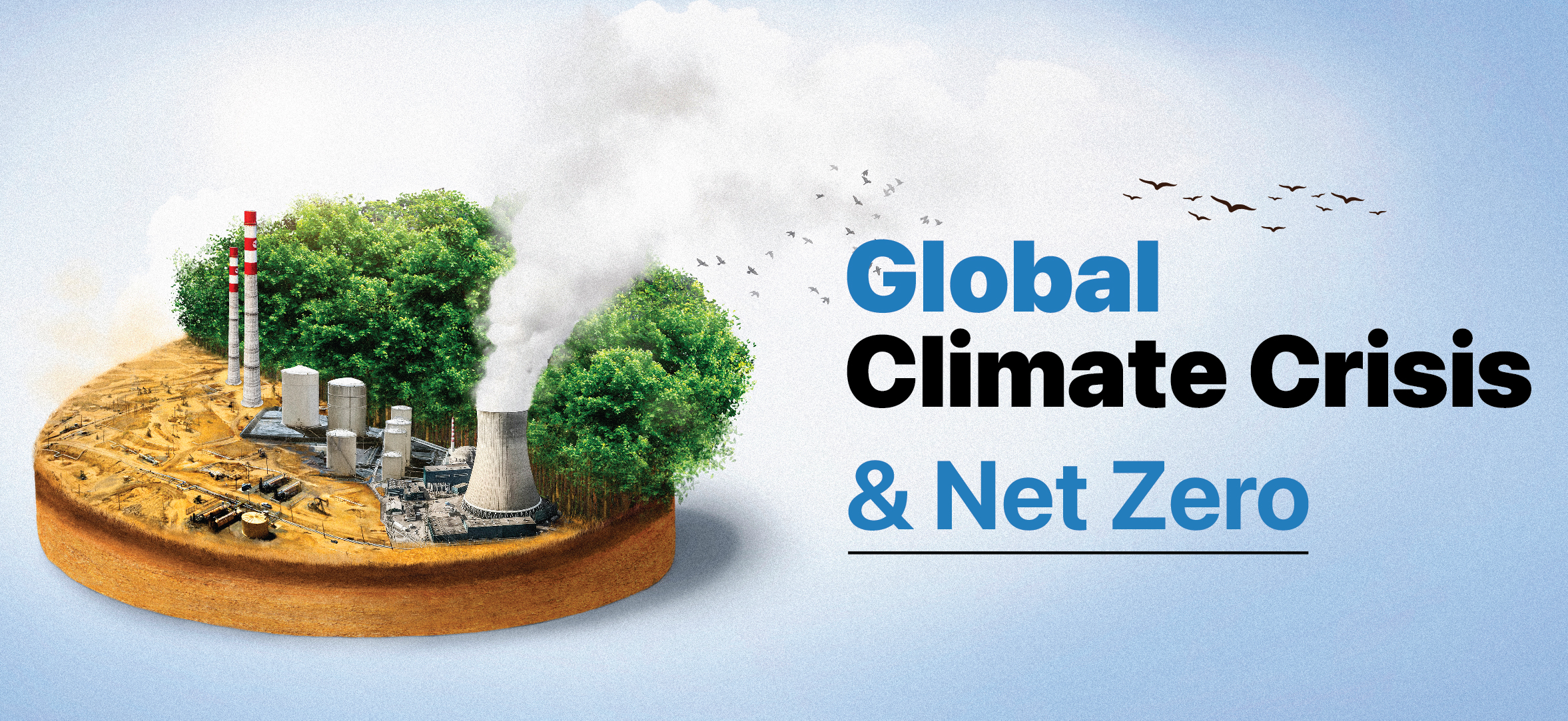Global Climate Crisis and Net Zero
Blogs Home
- 17 Nov 2023

Natural climate changes have shaped Earth's history, from ice ages to warm periods. Yet, since the industrial revolution, human activities, notably fossil fuel use, have intensified the greenhouse gas effect, causing global warming. Key contributors include energy consumption, industrial processes, vehicular emissions, deforestation, and landfills. The consequences are evident: glacial melting, rising sea levels, warmer oceans impacting currents, heightened extreme events, and declining biodiversity. This unnatural warming disrupts Earth's systems.
Climate Change: A Race Against Time
Since 1880, the average global temperature has risen by 1.1°C, of which the majority of warming has happened after 1975 (NASA GISS). The current international agenda as reflected in the Paris Accord is to limit the warming to 1.5°C from pre-industrial levels to secure a livable future for all. A 2°C rise will set a chain of irreversible reactions in Earth's climate. Despite the scientific community and activists pushing for long to take climate action, a lack of political will, institutional changes and industry accountability have kept us way beyond the target. At current policy rates, we are projected to reach a 2.8°C rise by 2100.
Going Net Zero:
The concept, embedded in physical climate science, refers to a state of Earth's atmosphere where the anthropogenic GHGs released into the air are balanced by the removal of an equal amount. The Net zero target on an international level was the first time set by the Paris Climate Accord (entered into force on 4 November 2016).
The Need for Net Zero:
To keep the global temperature within the limit, only a specific amount of CO2 and other GHGs can be present in the earth's atmosphere. Any increase above that budget should be countered by removal into natural or artificial sinks. Net zero is crucial to keep the temperatures around 1.5°C and forms an important reference level to keep the individual national emissions in check. It becomes pivotal as 1.5°C targets are critical to keeping severe climate change-related disasters under control (IPCC).
Challenges in Transitioning to Net Zero:
- Lack of transparent pathways to net zero
- Absence of Nationally Determined Contributions (NDC) that plan the climate strategy of countries to reduce emissions including the financial details.
- Limited expertise availability
- Energy security in energy transition: energy security has increasingly become a prime focus, especially after the Russia and Ukraine war (Russia being an important global supplier of gas). Alternative energy with low GHG emissions comes mostly from sources that vary with weather, impacting the sustained supply of energy. Storage of such energy for longer durations is currently a challenge.
- Limited Alternative Energy Production
- Higher cost of infrastructure and technologies required for green energy.
- Missing clear sectoral targets for industries
- Integrity and credibility of non-government entities. Although net-zero targets are increasing, the robustness of these pledges sometimes does not match the international standards laid out in the Race to Zero campaign.
- Hi
gh upfront investment costs.
- Accurate emission calculations: Difficulty in estimating and reducing supply chain emissions.
- Pace of technology: remains slow to achieve such a dramatic shift in emissions.
- Fair and ethical: Emission reduction should be sustainable with regard to its impact on the poor and vulnerable.
Solutions to Achieve the Goal:
Transitioning to net zero means a complete overhaul in consumption and production patterns. Switching to clean energy and electrification of transport and industry would help in faster decarbonisation. But simply reducing fossil fuel emissions is not a panacea; CO2 has decades-long impacts, which calls for urgent removal of existing CO2 from the atmosphere.
Carbon Sequestration Mechanisms: Carbon capture and storage from the atmosphere naturally or artificially removes the CO2 present.
- Natural carbon sequestration: by plants and open soil.
- Geological carbon sequestration: in deep porous rocks or saline aquifers.
- Technological carbon sequestration: graphene production, direct air capture and engineered molecules or ionic liquids that absorb GHGs Or CO2 from the atmosphere directly.
Innovative Strategies and Technologies:
- Artificial Intelligence:
- for speedier carbon emission calculations. (Altruistiq is a company that employs AI).
- to assess climate-related risks, provide integrated information and help adapt to extremes (ClimateAI).
- Carbon Capture Technologies:
- Affordable Direct Air Capture: refers to the direct removal of CO2 from the atmosphere, a promising but currently very costly technology. If carbon captured is further sequestrated or brought to use it is referred to as Direct Carbon Capture and Sequestration.
- Carbon capture usage and storage: refers to capture from point sources like power plants etc, its transport and storage.
- Financing: proactive investment and financing into technologies that produce "high volume industrial commodities" (like steel, hydrogen, cement etc) without emitting carbon.
- Energy Storage Technologies: Long-Duration Energy Storage (LDES): technologies that can be quickly deployed and scaled to different levels for supplying continuous clean energy (eg: Energy Dome, e-Zinc).
- Energy Efficient Hardware: development to reduce power losses in transit and insulation.
- Digitisation: automated sensor-based lighting and heating systems; dimming lights for energy-smart buildings.
- Decarbonisation of buildings: passive energy use, low-carbon concrete mix, minimal use of high carbon footprint (CF) materials like metals, reusing construction materials and renovating old buildings.
- Low-carbon Foods: Cultivated meats derived from lab-based proteins (eg: Shiok Meats) have a lower footprint as compared to traditional meats. This emerging industry can also help preserve the biodiversity crucial for climate adaptation.
Strategies and Policies Aiming Net Zero:
More than 70 countries have pledged to a net zero target. Race to Zero is a UN effort for non-state actors to adopt rigorous climate action.
- National climate action plans: all countries need to adopt detailed sectoral outlined climate action plans to reduce emissions.
- Carbon pricing and regulations: refer to putting a price on carbon pollution to bring down the emissions. It includes Emission Trading System (ETS) and Carbon Taxing (CT). The former is a cap and trade system capping the amount of GHGs emitted, allowing low-emitting industries to trade it with high-emitting ones. CT is levied on fossil fuel products according to their carbon content proportion. As per the world bank, the report, outlining the most recent advancements in global carbon pricing, indicates that there are currently 68 active direct carbon pricing mechanisms in operation worldwide.
- Indirect Carbon Pricing:
- removing fossil fuel subsidy
- taxing fuels
- payment or incentives for emission reduction ( Switzerland voters in June 2023 approved the Climate and Innovation Act which offers incentives to individuals and companies to reduce their emissions.)
- Investment redirection: into clean research and development projects. Inflation Reduction Act ,2022 USA subsidises clean energy and invests in home energy efficiency improvement, climate-smart agriculture, technology etc.
- Climate Policy Action, India:
- India has set its NDC.
- Clean energy installation and subsidisation: PM Kusum Yojana for solar pumps in agriculture and installing solar setups in houses provides subsidy on electric bills. The purchase of solar equipment is also subsidised.
- Energy Conservation Act 2022: focuses on a decrease in energy intensity, empowers Union and States to enforce energy efficiency and conservation, provides for penalties and adjudication and an appellate tribunal. It also specifies a minimum share of non-fossil fuel energy to be deployed by different sectors, energy conservation and sustainable building codes.
- Carbon Credit Trading Scheme (CCTS): under the above Act, CCTS has come into force in 2023, wherein Carbon credit certificates will be provided to the conforming entities.
Positive Impacts of Net Zero
- Environment: keeping global warming and climate change in check influences biodiversity and ecosystem health positively, limiting extreme disaster risk and preventing natural cycles from disruption.
- Economy: long-term economic sustainability as the climate change initiated extreme events may bring economic crashes. Transition to low carbon industries and promotion of a circular economy.
- Society: improvement in health with lower levels of pollution and decrease in deaths related to extreme weather events. Increased emitter responsibility protecting society from indirect and undue price paid.
Call For Action:
"Leadership is influence," stated JC Maxwell, emphasising the need for world leaders to embrace eco-friendly lifestyles. The Dutch Prime Minister's choice of cycling over car rides sets an example, with Dutch citizens avoiding 1.41 million tons of CO2 annually, equivalent to planting 54.4 million trees (UNEP). Global adoption of cycle-to-work schemes with financial incentives is crucial.
India's Mission LiFE promotes sustainable living. PM Narendra Modi's preferences for Khadi clothing, recycled PET fabric, plant-based diets, and climate-resilient crops showcase eco-conscious choices. The G20 conference and US state dinner featured vegan and millet-based food.
"Reduce, Reuse, Repair, and Recycle" initiatives lower carbon footprints. Advocating low consumption, buying second-hand, and repairing products help reduce CO2 emissions. Composting significantly reduces household emissions; supporting large composters and local recycling plants is essential.
Stringent laws combat food wastage. France's Food Waste Law, along with similar laws in Singapore, Italy, Japan, and China, compels grocery stores to donate edible items. India's Food Sharing Alliance encourages food donation but requires stricter laws to address waste and improve composting infrastructure.
Redirecting consumer expenditure toward eco-friendly options is vital for global climate action. Emphasising that climate responsibility is everyone's concern, individuals and nations should prioritise choices that have a positive impact on the planet.
Conclusion
In the UN Decade on Ecosystem Restoration, despite limited investments in climate-friendly sectors and a substantial focus on fossil fuels, the net zero goal has gained traction. Responsibility spans from individuals to institutions and industries to consumers, emphasising shared commitment to climate catastrophe prevention. Achieving net zero relies on innovation and stringent laws, with mass awareness and mobiliation being imperative. Individual efforts and choices shape consumer demand, driving fair, sustainable, low-emission supplies. India's investments in solar energy and vehicle electrification, coupled with low legacy emissions, position it favourably in containing warming to 2°C. Our commitment to climate action today shapes Earth's future.
References:
https://earthobservatory.nasa.gov/world-of-change/global-temperatures
https://netzeroclimate.org/what-is-net-zero-2/
https://www.nature.com/articles/s41558-021-01245-w
https://www.un.org/en/climatechange/net-zero-coalition
https://www.imf.org/en/Publications/fandd/issues/2022/12/bumps-in-the-energy-transition-yergin
https://www.worldbank.org/en/programs/pricing-carbon
https://qz.com/india-must-cross-these-hurdles-to-turn-net-zero-by-2070-1849566518
https://pib.gov.in/PressReleasePage.aspx?PRID=1923458
https://www.imf.org/en/Publications/fandd/issues/2022/12/america-landmark-climate-law-bordoff
https://www.un.org/en/actnow/ten-actions
https://www.imf.org/en/Publications/fandd/issues/2022/12/america-landmark-climate-law-bordoff
https://www.unep.org/news-and-stories/story/cycling-better-mode-transport
https://www.imf.org/en/Publications/fandd/issues/2019/06/what-is-carbon-taxation-basics
Sakshi Naithani
Sakshi has done her Masters in Geography from Delhi School of Economics, University of Delhi. She is currently pursuing Ph.D. in natural hazard risk assessment from Indian Institute of Remote Sensing-Kumaun University. When not engaged in research work, she loves to write poetry.
Blogs Home




